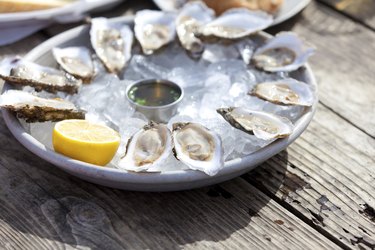
Contaminated foods, including raw oysters, cause illness in approximately 48 million Americans every year, according to a 2011 report by the Centers for Disease Control and Prevention. Several organisms can cause food poisoning from raw oysters, including norovirus and Vibrio bacteria. Most people recover from the unpleasant symptoms of food poisoning within a few days. However, one strain of Vibrio bacteria can cause life-threatening illness in people with cancer, HIV or liver disease.
Norovirus Food Poisoning
Video of the Day
Norovirus, the cause of nearly 50 percent of all reported cases of food poisoning, is often related to eating contaminated fruit, leafy greens or shellfish such as oysters, according to the CDC. The virus can also be passed by touching a contaminated surface or by person-to-person contact. Symptoms such as nausea, vomiting, watery diarrhea and abdominal cramping typically occur within 12 to 48 hours of exposure. Otherwise healthy adults generally recover within 3 days without needing medical care.
Video of the Day
Vibrio Food Poisoning
Vibrio bacteria that thrive in warm coastal waters, including the Gulf of Mexico, can contaminate oysters before harvesting. Within 2 to 48 hours of eating raw oysters contaminated with Vibrio parahaemolyticus, symptoms such as vomiting and non-bloody diarrhea can appear, lasting 2 to 8 days. If the infection is caused by Vibrio vulnificus, however, similar symptoms generally appear within 1 to 7 days, and can result in more serious disease, particularly in susceptible people.
Treatment
Treatment of food poisoning caused by contaminated oysters generally focuses on replacing fluids and electrolytes lost from vomiting and diarrhea. Consuming a clear liquid diet and taking over-the-counter medications to manage symptoms is usually sufficient in otherwise healthy people to affect a full recovery within a few days. If you notice bloody stools, develop fever and chills, or your symptoms worsen or fail to resolve, contact your doctor immediately.
Warnings
People with cancer, HIV, liver disease, alcoholism, diabetes and other causes of immune compromise are at greater risk of developing septicemia or blood infection from a Vibrio vulnificus infection. The bacteria invade the bloodstream, causing death in approximately 40 to 60 percent of reported cases, according to "The Microbiology of Safe Food," published in 2013. If you experience a fever, chills, nausea and sores or lesions on the skin within a few hours to several days after eating raw oysters, seek immediate medical attention.
Prevention
The U.S. Food and Drug Administration recommends cooking oysters using specific preparation guidelines to prevent food poisoning. If you prepare them at home, throw out any uncooked oysters that have open shells. Boil oysters in the shell for 3 to 5 minutes after they open. If you use shucked oysters, fry or boil them for at least 3 minutes, or bake them for 10 minutes in a 450 degree F oven. If you order oysters at a restaurant, refuse raw oysters and make sure that cooked oysters have curled edges.
- Centers for Disease Control and Prevention: CDC 2011 Estimates: Findings
- Merck Manual for Health Care Professionals: Overview of Gastroenteritis
- Centers for Disease Control and Prevention: Norovirus: Trends and Outbreaks
- Food Safety: Vibrio Infections
- U.S. Food and Drug Administration: Vibrio Vulnificus Health Education Kit Fact Sheet
- Centers for Disease Control and Prevention: Norovirus: Clinical Overview
Is this an emergency? If you are experiencing serious medical symptoms, please see the National Library of Medicine’s list of signs you need emergency medical attention or call 911.